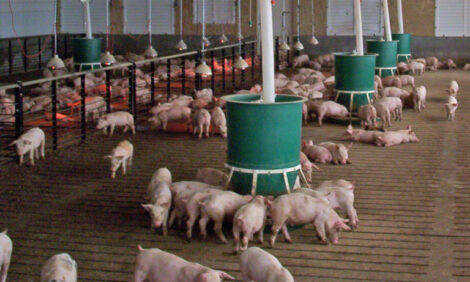



Pit Foaming and Manure Gases
Douglas Richards, Swine Grower Finisher Specialist, warns about the potential dangers of dealing with liquid manure in confined spaces like barns or pump out ports in the December 2010 Pork News and Views newsletter from Ontario Ministry of Agriculture, Food and Rural Affairs (OMAFRA).In the past year, Ontario pork producers have reported several occurrences of manure pits under slatted floors producing large volumes of black foam. The foam can fill up pits, exit pump-out ports, push through pit fan ventilation openings, and rise through the floor slats. Though the cause of the foam and how to prevent it are still unknown, producers should be aware of the possible dangers that the foam can cause.
Whenever you are dealing with liquid manure in confined spaces like barns or pump out ports, there is always the danger of hazardous gases. Methane (CH4) and hydrogen sulphide (H2S) gases are always produced during anaerobic breakdown of manure in manure pits.
The risk of these manure gases becoming a serious and possibly deadly problem can be minimised if managed properly. As the gases are released and become trapped by foam at the surface, the foam then starts to build up.
When the foam is disturbed by pig activity, power washing, water sprinklers or agitation, it releases methane and hydrogen sulphide gas. If the ventilation system cannot clear the volume of released gases, they can be trapped in the barn, with potentially deadly consequences.
Methane
Foam captures methane and when bubbles are broken, through agitation or other means, it rapidly releases methane. Methane concentrations inside the foam are 60 to 70 per cent, which is above explosive concentration. When foam bubbles are broken, methane accumulates in the barn space above the pit and becomes explosive. Methane is lighter than air and will rise to the ceiling of the room. When methane exceeds four to five per cent of the air volume and there is a flame or spark from a heater pilot light, electric or gas motor, light switch, an explosion may occur. This has been the case with some barn explosions in the Midwest USA.
Hydrogen sulphide
Hydrogen sulphide, which is heavier than air, will accumulate at the surface of the pit, base of the floor or foam. This gas is lethal in very small quantities and can cause death to pigs and humans.
Safety Precautions
Keep people out of buildings if you suspect any problems related to manure gases. Cost-effective gas monitors which constantly monitor and display carbon dioxide (C02) or hydrogen sulphide, with a range from 0 to 500 ppm, in 1-ppm increments, are available from approximately C$140.
- Ventilate properly/check to see if ventilation is working
- Never agitate without having all ventilation fans operating and inlets open
- Make sure fan ventilated barns have proper static pressure to ensure maximum air flow and mixing, i.e. no windows or doors left open
- Pit ventilation working (remember pit fans may not work if foam is blocking or above pit ventilation outlets)
- Fans on full
- Open curtains fully on dual/naturally ventilated barns
- Ceiling inlets open
- Pump-outs sealed
- Mixing fans on if available
- Turn off pilot lights/other sources of ignition when agitating
- No rooster tailing with manure pump
- No agitation until manure is two feet below slats
- If possible, agitate intermittently
- Be extremely cautious when foam is being broken up.
For more information from OMAFRA on dealing with manure gases, click here.
Further Reading
| - | You can view the full previous article from this publication by clicking here. |
January 2011








